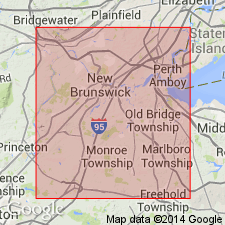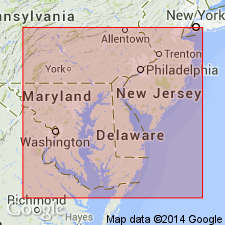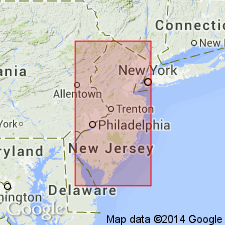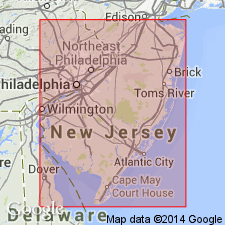
- Usage in publication:
-
- Raritan formation
- Modifications:
-
- Named
- Dominant lithology:
-
- Sand
- Clay
- AAPG geologic province:
-
- Atlantic Coast basin
Cook, G.H., 1888, Report of the subcommittee on the Mesozoic: American Geologist, v. 2, p. 257-268.
Summary:
Raritan clays described from measured section. Include (descending): Sand, clay, and lignite (50 ft); clay and sand (40 ft); stoneware clay bed (30 ft); sand and clay (50 t); South Amboy fire-clay bed (20 ft); kaolin (13 ft); feldspar, (5 ft); micaceous sand bed (20 ft); laminated clay and sand (30 ft); pipe clay (15 ft); Woodbridge fire-clay bed (20 ft); fire-sand bed (15 ft); Raritan fire-clay bed (15 ft); Raritan potter's clay bed (24 ft). Underlies Clay Marls [Matawan group] and rests on Archean. [As thus defined Cook's Raritan clays are 347 ft thick and include the Magothy formation of subsequent nomenclature.]
Source: GNU records (USGS DDS-6; Reston GNULEX).

- Usage in publication:
-
- Raritan formation*
- Modifications:
-
- Revised
- AAPG geologic province:
-
- Atlantic Coast basin
Summary:
Raritan formation, in Middlesex Co., NJ, divided into several distinct mappable units. Clays of Raritan have been extensively used in ceramic industry and received informal names. The other members, composed dominantly of sands were not named but given numbers: In this report these are given member names. Thus, Raritan comprises from top to bottom Amboy stoneware clay, Old Bridge sand member (No. 3 sand of previous reports); South Amboy fire clay, Sayreville sand member (No. 2 sand), Woodbridge clay, Farrington sand member (No. 1 sand), and Raritan fire clay. Underlies Magothy formation. Upper Cretaceous.
Source: GNU records (USGS DDS-6; Reston GNULEX).

- Usage in publication:
-
- Raritan Formation*
- Modifications:
-
- Revised
- AAPG geologic province:
-
- Atlantic Coast basin
Summary:
Old Bridge Sand Member removed from Raritan Formation and made basal member of Magothy Formation.
Source: GNU records (USGS DDS-6; Reston GNULEX).

- Usage in publication:
-
- "Raritan" of Maryland
- Modifications:
-
- Revised
- AAPG geologic province:
-
- Atlantic Coast basin
Summary:
Pollen and spore studies have shown that there is little, if any, time break between the beds in MD assigned to the Lower Cretaceous Patapsco and the Upper Cretaceous Raritan Formations and that the so-called Raritan beds of MD (the "Elk Neck Beds" of Wolfe and Pakiser 1971) are older than the Raritan of the type area in northern NJ. In this report, Potomac Group is undifferentiated as the Patuxent and Patapsco are so lithologically similar that it is difficult to distinguish between them in the field. However, the uppermost beds of the Potomac Group, which contain plant fossils of Late Cretaceous age are here referred to informally as the "Raritan" of Maryland. [This manuscript was reviewed by the GNU in 1973, but was not published until 1990. Field work for this study was done in the late 1960's. The nomenclature in this report may not reflect current usage.]
Source: GNU records (USGS DDS-6; Reston GNULEX).

- Usage in publication:
-
- Raritan Formation*
- Modifications:
-
- Age modified
- AAPG geologic province:
-
- Atlantic Coast basin
Summary:
Raritan Formation is Late Cretaceous (Cenomanian) based on work by Cobban and Kennedy (1990, Upper Cenomanian ammonites from the Woodbridge Clay Member of the Raritan Formation in New Jersey: Journal of Paleontology, v. 64, no. 5, p. 845-846).
Source: GNU records (USGS DDS-6; Reston GNULEX).

- Usage in publication:
-
- Raritan Formation*
- Modifications:
-
- Overview
- AAPG geologic province:
-
- Atlantic Coast basin
Summary:
Late Cretaceous Raritan Formation present in MD where it overlies Potomac Group.
Source: GNU records (USGS DDS-6; Reston GNULEX).

- Usage in publication:
-
- Raritan Formation*
- Modifications:
-
- Revised
- AAPG geologic province:
-
- Atlantic Coast basin
Summary:
The South Amboy Fire Clay Member is removed from the Raritan Formation and included with the overlying Magothy Formation in NJ.
Source: GNU records (USGS DDS-6; Reston GNULEX).
For more information, please contact Nancy Stamm, Geologic Names Committee Secretary.
Asterisk (*) indicates published by U.S. Geological Survey authors.
"No current usage" (†) implies that a name has been abandoned or has fallen into disuse. Former usage and, if known, replacement name given in parentheses ( ).
Slash (/) indicates name conflicts with nomenclatural guidelines (CSN, 1933; ACSN, 1961, 1970; NACSN, 1983, 2005, 2021). May be explained within brackets ([ ]).

